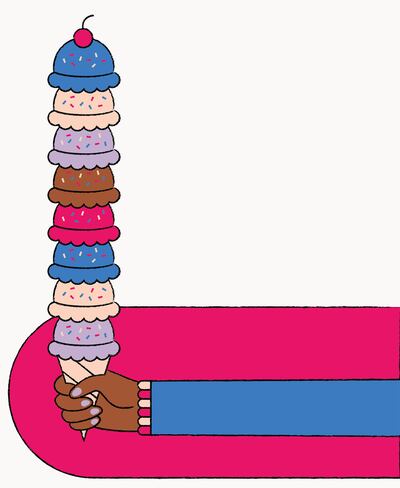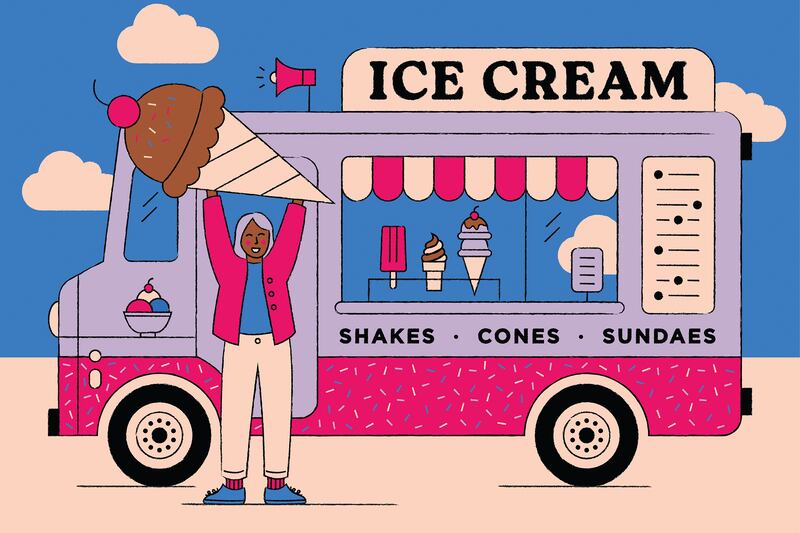Ice cream is synonymous with an American summer. When a familiar ditty plays over the tinny speakers of an ice-cream truck in any neighborhood, mouths of all ages begin to salivate. There are other foods we eat when it’s hot — like watermelon, hot dogs and tomatoes — but ice cream helps to keep us cool and sane. From modern gourmet flavors to the humblest grocery store brand, there’s no such thing as bad ice cream, especially if it’s fresh. Here’s why there’s so much to love.
4 Billion Pounds
That’s how much ice cream Americans consume annually, amounting to more than 20 Nimitz aircraft carriers. That’s based on an estimate that the average American eats 12 pounds in a year — down from a whopping 16 pounds per person in 2000. Nearly three-quarters of us still report eating ice cream at least once a week.

September 9, 1843
On that day, Philadelphia housewife Nancy Johnson obtained a patent for a device that would revolutionize the “art of producing artificial ices.” Her invention, the basis of today’s standard ice cream churns, improved on an age-old treat similar to snow ice cream. Roman emperor Nero sent slaves to the mountains to collect snow and ice to be mixed with fruit and honey. Other iced treats were created in China and other ancient civilizations.
1920
That’s when a man named Harry Burt of Youngstown, Ohio, first sold ice cream from a truck. The food’s popularity surged during Prohibition, as adults who could no longer drink alcohol legally turned instead to sweets. Burt also founded the Good Humor brand, known for his novelty “ice cream on a stick” and salesmen who tipped their hat to women and saluted men.
“We simply don’t have enough good quality evidence to suggest that ice cream definitely has any health benefits. But a couple of small portions a week — paired with an otherwise healthy diet and exercise regime — is unlikely to do much harm.” —Duane Mellor, Aston University
4 Ingredients
Thomas Jefferson’s recipe for ice cream — likely passed on by his French butler, found among 10 handwritten recipes in the third U.S. president’s personal papers — called for just two bottles of good cream, six egg yolks, a half-pound of sugar and a stick of vanilla. The process, however, was fairly complicated, including towel-straining and a fire. His successor’s wife, Dolley Madison, had more exotic tastes, with a predilection for oyster ice cream.
$100 a week
By 1932, Good Humor drivers were earning that much each week, more than $1,800 when adjusted for inflation. While the tell-tale jingle may feel less common now, business is thriving. One company in Massachusetts said its drivers make $20-$30 an hour, plus tips — plus a signing bonus. And in a new twist, certain ice-cream truck drivers in New Jersey will show up at your door if you text them.

-109.3°F
Orders shipped from Jeni’s Ice Creams of Columbus, Ohio, arrive sci-fi cold, thanks to dry ice. Competitors from specialty shops to large retailers like Harry and David’s also ship anywhere in the U.S. In recent decades, weird science has also gifted us with “beaded” ice cream like Dippin’ Dots and nitrogen ice cream from a Utah-based chain called Sub Zero.
10% Milkfat
That’s the threshold for a product to qualify as ice cream, according to the federal government, in a mixture of dairy, sweetening and flavors that must weigh 4.5 pounds to the gallon. Vegan ice cream is out. So are soft-serve cones and other fast-food frozen dairy treats. And while most brands at the supermarket qualify, many are also ultra-processed foods, linked to signs of addiction in a recent study by the University of Michigan.
31 Flavors
The old Baskin-Robbins moniker sounds quaint in a world with ice creams that taste like mac and cheese, dill pickles, lobster and Thanksgiving dinner. Polling shows New York still prefers pistachio; South Dakota loves birthday cake; and Oregonians favor green tea. For Utahns, nothing tops rocky road — chocolate ice cream with nuts and marshmallows — which was adventurous for the 1920s, when two companies in Oakland, California, claim to have invented it. The author prefers the taste of frozen custard, though it’s not even ice cream.
This story appears in the June 2024 issue of Deseret Magazine. Learn more about how to subscribe.


